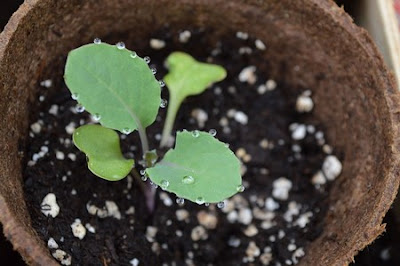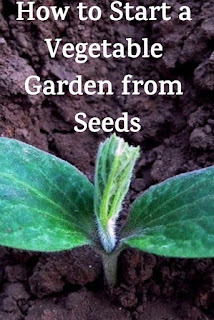Starting a garden from seeds is a good way to start your garden that will save you money. Usually, plants at a garden shop can be expensive and sometimes the plants you get from a garden shop might not be very healthy or they could come with bugs. Starting from seeds, you can be sure to have healthy plants to place in the garden.
What You Will Need to Start a Vegetable Garden From Seed
To start plants indoors, find a room or area in your house that will get plenty of sun. A south-facing window would be best, but an east or west-facing window will work fine.
Decide which vegetables and herbs you want to start indoors. You can start any vegetable by seeds indoors like tomatoes, peppers, green beans, squash and more. Vegetables like carrots and radishes can be started in the garden when it is warm enough.
You can buy seed packets from a catalog such as Burpee or buy the seed packets at any garden shops and online.
You should not use dirt from outside to start the seeds, but you can. Regular soil from outside is too heavy or dense and could contain bugs that eat your new seedlings. You will have enough time when you plant the plants outside in the garden to worry about bugs.
You should use seed starting soil mix that you can get at garden shops at the same time you get pots. The seed starting soil is specially designed for starting seeds.
I like to use small peat pots to start seeds in. You can use peat pots, paper pots or soil blocks. When it comes time to transplant the seedlings into the garden, these pots make it easier to get the plants out.
Even though you can plant the new plants into the garden peat pot and all, I prefer to carefully take the plant out of the peat pot and transplant the plant directly into the garden.
I have seen in the fall some plants that had a tight root ball still in the peat pots that never broke down during the growing season. You can buy seed pot trays with the pots for an easy way to start your garden indoors.
How to Start Seeds
Start by putting the seed starter mix in the pots and wetting the dirt but don’t flood it. Pack the dirt down firmly. Make the holes about 1/8” deep. Put a seed in, I usually put two seeds per pot depending on the plant. For plants like squash or green beans that are rather big, I might just put in one per pot since they always seemed to germinate and grow.
Don’t start the seeds too early, about 6 - 8 weeks or so before it is time to plant them in your vegetable garden. You don’t want them to sit in the small pots once they get too big.
Once you have all your pots seeded with the plants, put them in some type of tray. I have used trays like you get with a case of beer or pop. This makes the seed pots easier to move. Label your pots in some way so you know what is coming up.
Put the pots in a sunny location in the house, a south facing window is best but good direct sun from the east or west will work. Seeds germinate best at about 70-80 degrees F. Put some plastic like saran wrap loosely over the top of the pots to keep the moisture and heat in to get them to germinate.
Since the seeds will be near a window for the sunlight, you want to make sure they don’t get a blast of cold air at night from these same windows, so keep the curtains closed.
Some people will move the tray of seeds to the top of the refrigerator for the heat at night or some other warm place.
Tip: Watering the seeds in the pots can be difficult, you might flood the pots and the seeds might move to the edge or float to the top. A spray bottle can work nicely for watering these plants. Germinating seeds just takes moisture and warmth. Don’t let the pots dry out and over-watering can cause the seeds to rot
Tip: It also helps to have some air circulating around the plants, a ceiling fan or a fan set to low just to get air circulating in the area.
Not all the seeds will germinate and come up and in some of the pots you might have several come up, you can thin them and keep the best one or if more than one looks really good, you can separate them when it is time to plant them.
Hardening the Garden Plants
Before planting them in the garden, you need to harden them off. This means that you have to introduce your new plants to the outdoors slowly. If they have been indoors a long time, it will take longer to get used to being outdoors.
When you first move them outside, do not put them in direct sunlight, put them in shade and protected from the wind. Watch them because they can dry out quickly. You can also use a cold frame. The first couple of days outside you should never leave them out below 50 degrees.
Bring them in at night when you think it will be too cold for them, they will die quickly at freezing temperatures. Basically, you’re getting them used to the outdoor climate.
Common Problems
Leggy seedlings: What you get is a long limp stem and then it flops over. This can happen when there is not enough light or not enough air circulation and too much heat. If this happens you can start over or you can repot the plant deeper.
Leaves stuck to the seed: This happens when the first leaves from the seed (the cotyledons) are stuck to the seed. Don’t try and separate them, they usually separate on their own. To help this along, continue to keep it moist with the spray bottle.
Damping off: This is a fungus in the soil that can cause the stems of the new plants to be very narrow where the stem meets the dirt.
This will kill the seedling. Ways to avoid this is better air circulation and using the premixed starting soil. Also, make sure there is good airflow, don’t cut off the air flow when putting plastic over them too tight.
Copyright © 2009-2019 Sam Montana
How to Make Compost


No comments:
Post a Comment